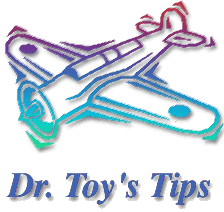
Also see :
Dr. Toy's Tips for Keeping Toys Clean and Safe.
Dr. Toy's Tips on Selecting Children's Products
As you examine any potential children's product, before you purchase it, ask yourself the following questions:
- Is the product appropriate now? Does the product fit the child's age, skills and abilities?Will it hold the child's interests?
- Is the toy /product well -designed? Is it safe? Are there any potential hazards such as sharp edges, parts that can be swallowed, or loose ties? Is it non-toxic? Does it meet Consumer Product Safety Standards? How durable is it? Will it take rough treatment? Is there a guarantee on the product?
- Is the toy or product appealing? Is it something the child will enjoy using for a long time? Does it have long lasting play value? Does it have versatility?
- Does the toy offer an opportunity to stimulate creativity? The right products in arts, crafts, hobbies, language, reading, music, movement and drama can help to expand the child's imagination, thinking and comprehension.
- Does the toy match the package and the package match the toy? If the toy does not match ads or package it can be disappointing. Is age grading clear?
- Will the product teach? Does it help expand positive self-esteem, values, understanding, cultural awareness, Does it help encourage the growth of self-esteem, values, or cultural values offer practice in skills, eye hand coordination, or fine and large motor skills? Does the product help teach communication skills? Does it expand understanding of the environment, the community, and world? Does it teach or practice computer skills?
- Is the toy affordable? Does the price match the value received?
- Will the product frustrate or challenge the child? Does the product offer an opportunity to think, learn something new , practice or try something that will be beneficial? Or will it be too difficult for the child to use. However, the product may be perfect for doing an activity, a construction project, a craft, hobby, or playing a game. Having fun together as a family is an important part of the child's play experiences.
- Will the toy help to nurture childhood? Can the child use the product by themselves? Will it help them gain independent skills? Does the product help the child express emotions, experience care and concern for others, practice positive social interaction? Is there any violence, sexism or negative aspect to the product?
- Is the toy fun? Most importantly will the child enjoy using the product? Will it make him or her laugh? Relax? Feel good? Play is after all a time to have fun. Learning is a lot easier and is more enduring if it's fun!
Think about these points:
-
What does your child need now and what is he or she ready to play with?
-
The right toy/product at the right price for the right reason will help make your child realize more joy, wonder, and learning.
-
Give your child a chance to tell you about the toys and products on their wish list.
-
Consider one of those fantasy products the child wants, even if you think its silly. The child is only this age once. Even if we don't agree about their choices, they need to learn to be responsible for decisions they make as consumers. They are influenced a lot by what their friends are playing with and by what they see on television.
-
Make a point of examining the toys and products included on Dr. Toy's extensive list of great new award winning products. Each one has extra value of activity, creativity, or education built in and your child will benefit.
Let's Play!
Dr. Toy.
Also on this site:
Dr. Toy's Tips for Keeping Toys Clean and Safe.



